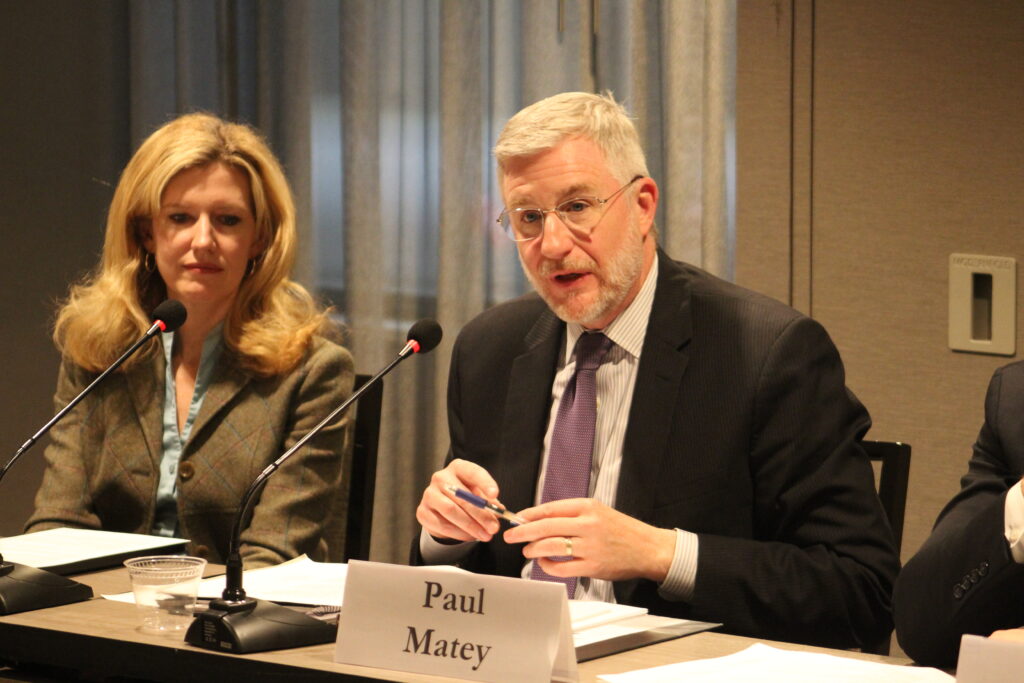
In Part One of this essay, I argued that the Supreme Court’s opinion in United States v. Rahimi set the stage for lawyers and judges to incorporate natural law principles into their reasoning. In Rahimi, the Court appealed to the “principles underlying the Second Amendment” in order to ascertain the scope of its protections. Our historical tradition—including the adoption of the Second Amendment and related firearms regulations—was based on certain fundamental moral principles inherited from centuries of natural law thinking. Appeals to the “principles that underpin our . . . tradition” are therefore actually attempts to reach those basic natural principles.
What does that mean for the lawyers and judges faced with applying the Rahimi standard?
Judge Paul Matey’s concurrence in the Third Circuit case Range v. Attorney General provides a template for applying Rahimi to Second Amendment cases. The case involved the federal felon-in-possession statute, 18 U.S.C. § 922(g)(1), which disarms anyone “who has been convicted in any court of, a crime punishable by imprisonment for a term exceeding one year.” In 1995, Bryan Range and his wife faced hard times and struggled to raise their three children. They filed an application for food stamps that understated Range’s income, and he was subsequently convicted of welfare fraud. Though the crime was classified as a misdemeanor—and Range was sentenced to only three years’ probation and fines—the crime was eligible for a sentence of up to five years’ imprisonment. Section 922(g)(1) therefore rendered Range permanently ineligible to possess a firearm.
The en banc majority applied Bruen’s historical framework to hold that Range’s permanent disarmament violated his Second Amendment rights. Judge Matey concurred, writing separately “to explain why that conclusion follows classical principles respecting the natural rights that inform ‘our regulatory tradition.’” He did not disagree with the majority’s exploration of our historical tradition. Citing Hadley Arkes, he recognized that reason supplied the grounds for the Founding tradition. From there, he followed the logic of Rahimi, explaining how an examination of our regulatory tradition therefore “demonstrates the ‘reason and spirit’ of the law, or the ‘principles underlying the Second Amendment.’”
Judge Matey traced our tradition of arms-bearing for defense back to Roman law and the legal philosopher Cicero. The tradition evolved through the work of classical Natural Law thinkers like Aquinas. From there, he explained how English law “applied and developed these principles.” While the right to have arms for defense was enshrined in the English Bill of Rights, England also enacted laws to stop “men [from] exercising their fundamental rights to intentionally harm the life or safety of another, or to rebel against a just government.” A number of English laws prevented use of arms to commit violence against the community—including the going-armed and surety laws relied upon in Rahimi. Others “curtailed the right to bear arms of individuals suspected of treason or sedition against the sovereign.” These laws targeted individuals deemed seditious, as well as groups like Catholics who were thought to have split loyalties.
Both the principle of defense and the laws securing the safety of the community survived the Founding. The Second Amendment preserved the natural right to bear arms for defense of self and others. At the same time, colonial and state laws allowed the arrest and disarmament of those “who ride, or go, offensively armed, in Terror of the People.” Groups like Catholics and loyalists were disarmed because of seditious fears. In light of the tradition these historical laws comprised, Judge Matey extracted two parallel principles. “First, the right to bear arms is not a license to physically harm another. Second, an individual cannot exercise that right to rebel against a just government ordered for the common good.” Violating those principles historically resulted in disarmament.
Bryan Range’s crime did not involve physical violence against another. Nor was it seditious. He misrepresented his finances in order to receive aid in feeding his family. Because Range’s conduct did not fall within either of the principles described above, Judge Matey concluded that “disarming him is unnecessary to ensure the physical safety of the community, or the continuity of government” and the disarmament violated the Second Amendment.
Judge Matey’s concurrence follows the roadmap I suggested in Part One. He examined our historical laws as an extension of the Western tradition the Founders inherited. The laws implement deeper natural law principles, and so serve as evidence of those principles. Once ascertained, the principles can guide the contours of legal interpretation. That is fundamentally the logic of Rahimi, and it is made evident in Judge Matey’s concurrence.
The principles identified by Judge Matey, and by the Court in Rahimi, as underlying the Second Amendment are not the only ones that might be extracted from our tradition of arms regulation. Consider a case involving a ban on so-called “assault weapons”—really just semiautomatic rifles with certain features like a pistol grip or removable magazine. At the core of the Second Amendment is the principle that it is right to defend oneself and community. This moral principle was implemented in part through one of our oldest traditions that spanned from twelfth-century England to after the Founding: requiring citizens to own arms to contribute to the common defense. And the Second Amendment was adopted, in part, because of the role arms played in the Revolutionary War. To the Founders, the widespread ownership of militia-grade arms enabled the natural right of defense.
This history of not only permitting, but requiring, possession of arms sufficient for community defense might reveal a principle useful in analyzing the issue of “assault weapons” bans. That is, regulations should not deprive citizens of possession of arms useful for defense of their community. As others have recognized, the scope of the application of that principle might be partially determined by other principles—i.e., principles regarding sovereignty and national security might limit its application to the most advanced weapons. But it would apply comfortably to commonly owned civilian weapons that possess certain tactical advantages like removable, high-capacity magazines. Guns like the AR-15 and its derivatives, therefore, would be protected from these bans.
This type of classical reasoning has been tentatively creeping into Second Amendment jurisprudence, but it need not stop there. Any area of law based on the principles that informed the Founding is primed for such considerations. As discussed in Part One of this essay, the English tradition we inherited was built on classical Western principles. The Founding built on, and was justified by, conceptions of natural rights and the moral duties of government. And the regulatory tradition that immediately followed was based on ideas about the natural source and scope of rights. When we look to the principles underlying our Founding traditions, therefore, we necessarily incorporate the Natural Law ideals of the Founders.
The Supreme Court has shifted to relying on history and tradition in the First Amendment context. Establishment Clause cases are now decided “by reference to historical practices and understandings.” For example, the Court’s approval of prayer to open a state legislative session was based in part on similar conduct in the First Congress. If the Court follows its logic in Rahimi in future Establishment Clause cases, this inquiry would not just be based on historical fact, but on the principles underlying traditional practices—put differently, we would look to the reason inherent in our historical practices and laws.
The First Amendment’s religion clauses are deeply informed by a natural duty—recognized for millennia—to seek to know God. Aquinas relied on Augustine for the proposition that “we ought to seek God again, whom we had lost by our neglect.” The Spanish scholastic philosopher Francisco Suarez thought that “it is the duty of a civil state, by virtue of reason and the natural law, to provide for the true worship of God within its borders.” Locke was less authoritarian about it, but thought that by nature of our creation, people ought to know and worship God. The Founders followed this philosophical tradition. James Madison, for example, wrote that we have a duty, “precedent, both in order of time and in degree of obligation, to the claims of Civil Society,” to render the Creator homage in an acceptable manner.
With this principle in mind, the Establishment Clause takes on a new light. It is not a mandate that the government be hostile to religion or suppress government employees’ expression of religious beliefs. Quite the opposite. The Clause serves as a protection against government interference with the fulfillment of the duty to seek God. This principle is seen in our historical practice as prayer and religious exercise pervaded Founding-era official action. The mere exercise of religion, even when associated with government employment, can therefore never be seen as inconsistent with the Clause so long as it does not stop other citizens from seeking God in accordance with their conscience.
Similar reasoning can be applied to the other First Amendment clauses or any area of law defined by Founding-era practice. The Due Process Clause of the Fourteenth Amendment, for example, protects unenumerated rights “‘deeply rooted in this Nation’s history and tradition’ and ‘implicit in the concept of ordered liberty.’” Following Rahimi, the scope of these rights can be defined by the principles underlying that tradition and those ideals that define ordered liberty—including the fundamental moral equality among all human beings regardless of age, race, or ability.
Rahimi took a crucial step forward from prior “history and tradition” cases by looking through the record of historical laws to the principles motivating them. As Judge Matey showed in his Range concurrence, these principles are traceable back to the classical Natural Law tradition. Rahimi therefore opens a door for lawyers and judges to appeal to classical Natural Law principles in cases involving the First, Second, and Fourteenth Amendments, as well as any other issue defined by our historical tradition. As the logic of Rahimi takes hold, so again can the classical reasoning that defined the Founding era.


